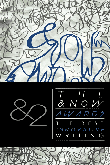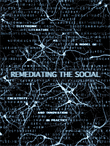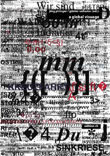J.R. Carpenter's Blog, page 5
December 2, 2013
TRANS.MISSION [UN.DIALOGUE]
At an excellent international conference on Translating E-Literature, which took place at Université Paris 8 in June 2012, I presented a paper which situated the process of adapting Nick Montfort’s 1k story generator story2.py (2008) into my web-based work TRANS.MISSION [A.DIALOGUE] (2011) in terms of an extended notion of translation.
An adaptation of that paper is available for download here: Translation, transmutation, transmediation, and transmission in ‘TRANS.MISSION [A.DIALOGUE]‘ (PDF)
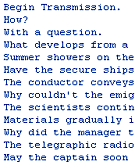 TRANS.MISSION [A.DIALOGUE] is a computer-generated dialogue, a literary narrative in the form of a conversation, a discourse propagating across, beyond and through long-distance communications networks created and necessitated by generations of transatlantic migration. One JavaScript file sits in one directory on one server attached to a vast network of hubs, routers, switches, and submarine cables through which this one file may be accessed many times from many places by many devices. Each time this JavaScript is called, the network, the browser, and the client-side CPU conspire to respond with a new iteration. The mission of the JavaScript source code is to generate another sort of script, a dialogue to be read aloud in three voices: Call, Response, and Interference; or: Strophe, Antistrophe, and Chorus; or Here, There, and Somewhere in Between. This multi-site-specific dialogue resonates in the spaces between places separated by time, distance, and ocean, yet inextricably linked by generations of immigration.
TRANS.MISSION [A.DIALOGUE] is a computer-generated dialogue, a literary narrative in the form of a conversation, a discourse propagating across, beyond and through long-distance communications networks created and necessitated by generations of transatlantic migration. One JavaScript file sits in one directory on one server attached to a vast network of hubs, routers, switches, and submarine cables through which this one file may be accessed many times from many places by many devices. Each time this JavaScript is called, the network, the browser, and the client-side CPU conspire to respond with a new iteration. The mission of the JavaScript source code is to generate another sort of script, a dialogue to be read aloud in three voices: Call, Response, and Interference; or: Strophe, Antistrophe, and Chorus; or Here, There, and Somewhere in Between. This multi-site-specific dialogue resonates in the spaces between places separated by time, distance, and ocean, yet inextricably linked by generations of immigration.
Although the translation of natural languages was not my focus in the paper I presented at Translating E-Literature, the inextricable association between language and nation necessitated the question: Were this work translated into French, would the location of memory also be translated, or re-placed, to reflect generations transatlantic migration from France to Nouvelle France? Would Cornwall be replaced with Bretagne, Nova Scotia with Acadie?
In 2013 TRANS.MISSION [A.DIALOGUE] was translated into French by Ariane Savoie, a PhD student at Université Québec à Montréal, for a special translation issue of bleuOrange, a Montreal-based online journal of ‘littérature hypermédiatique,’ which launched at the Electronic Literature Organization conference Chercher le texte in Paris 23-26 September 2013. Here is a direct link to Ariane Savoie’s truly remarkable translation: TRANS.MISSION [UN.DIALOGUE].
![Ariane Savoie presenting her translation of TRANS.MISSION [A.DIALOGUE] at Chercher le texte in Paris, September 2013](https://i.gr-assets.com/images/S/compressed.photo.goodreads.com/hostedimages/1386063972i/7283830.jpg)
IMAGE: Ariane Savoie presenting her translation TRANS.MISSION [UN.DIALOGUE] at Chercher le texte, Paris, September 2013
In personal correspondence Savoie shared certain thoughts on her process, which I synthesise here. A strict translation of all the English variables into French equivalents would have resulted in subject-verb gender disagreements, the resolution of which would require considerable modification to the source code, which, Savoie felt, would have diminished the variability of the generator and the structure of the piece. Instead, Savoie elected to respect the structure of the source code. Gender conflicts were avoided by the population of strings with variables from only one gender, letting go of any variables that didn’t have the exact equivalent in that gender in French. Initially, this resulted in an eradication of the gender variable altogether. Eventually, a compromise was reached in which two versions of certain variable strings were created, that both masculine and feminine proper nouns might be called at different points in the script.
Although the gender variable represented by the string var heshe=['he','she']; is not carried over into Savoie’s translation, something of the either/or binarism of that string endures, both through the introduction of gender variables through other means, as cited above, and through the variable string var place=, in which, the location of each place named is either on one side of the Atlantic or the other: Canada or England, Acadie or France, the new world or the old, home or away.
Many thanks et merci to Ariane Savoie, Alice van der Klei, et toute l’équipe de bleuOrange, and to Yves Abrioux and Arnaud Regnauld, co-organisers of Translating E-Literature.
LINKS:
Nick Montfort (2008) story2.py
Nick Montfort (2008) The Two
J. R. Carpenter (2011) TRANS.MISSION [A.DIALOGUE]
Ariane Savoi (2013) TRANS.MISSION [UN.DIALOGUE]
J. R. Carpenter (2012) Translation, transmutation, transmediation, and transmission in ‘TRANS.MISSION [A.DIALOGUE]‘ (PDF)
Tweet
November 27, 2013
I first logged onto the internet 20 years and 22 days ago today
On 93/11/05, in the PAVO lab at Concordia University in Montreal, I logged onto the internet for the first time. My user name was JR_CARP. I remember these details because I still have the ID card from that first account. After a few months of writing fictional posts to alt.arts.nomad and other USNET groups I got a UNIX account and dove into the wonderful worlds of Telnet, Archie, Gopher, FTP, Purple Crayon, LambdaMOO, c-theory, ALT-X, and so on. The rest, as they say, is a syslog file.
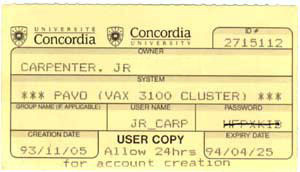
I’ve written about those way back times a number of times in a number of ways over the past twenty years. Here links to a few essays which are still online which I’m not too embarrassed about:
A Little Talk About Reproduction 1997
A Brief History of the Internet as I know it So Far 2003
Getting in on the Ground Floor: A Hazy History of How and Why We Banded Together 2007
A Non-Linear Time Line of 20 Years Online 2013
Collaborations are underway toward marking this anniversary. Berlin-based art critic and code-poet Elvia Wilk is currently slogging through the audio archive of an interview we did in London in October. And I am chipping away at answering questions posed by writer and researcher Andrea Zeffiro for what we’re calling an Object Oriented Interview for the Media Archaeology Lab in Boulder, Colorado.
In the meantime, here is a video interview the brilliant and delightful code-poet philosopher David Jhave Johnston did with me at The Banff Centre in 2012, for the series CAPTA: Conversations with poets about technology, in which, there is much discussion of the olden days of internet of yore.
Tweet
September 21, 2013
Catalogue Essay for Ingrid Bachmann, Pelt (Bestiary)
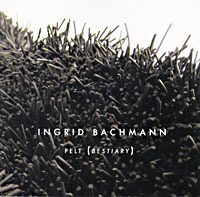 Earlier this year I wrote a wee catalogue essay on Montreal-based installation artist Ingrid Bachmann‘s work Pelt (Bestiary), which opened on April 13, 2012 at the Galerie Materia in Quebec City, Quebec, Canada. It was the opening show of the Quebec Art Biennale – “Manifestation internationale d’art de Québec” – Manif d’art 6, curated by Nicole Gingras, which officially opened May 3, 2012.
Earlier this year I wrote a wee catalogue essay on Montreal-based installation artist Ingrid Bachmann‘s work Pelt (Bestiary), which opened on April 13, 2012 at the Galerie Materia in Quebec City, Quebec, Canada. It was the opening show of the Quebec Art Biennale – “Manifestation internationale d’art de Québec” – Manif d’art 6, curated by Nicole Gingras, which officially opened May 3, 2012.
Copies of this gem of a catalogue arrived by post this morning. Here are the opening lines from my text:
I have seen Ingrid Bachmann stick electrodes into potatoes to see what sounds they make, and then stick them into into apples to compare notes.
The harmonic frequencies of fruits and vegetables, the private lives of hermit crabs, the stories we tell, the lies, the sublime secrets suitcases hold, the music used shoes make… Such is the breadth of her curiosity. Electric is her line of inquiry. Direct is her approach.
Much of Bachmann’s work with technology has been aimed at demystifying it, humanizing it, stripping it down to its essentials, and then hanging stories on those bare bones. She has used bits of yarn to map the internet’s under-sea cables, harnessed the computer loom to “print” seismic activity, offered giant knitting needles as a user-computer interface.
It is through this material sensibility that we must approach this new work.
And here is video documentation of Pelt (Bestiary).
Tweet
September 16, 2013
A Non-Linear Timeline of Twenty Years Online
November 2013 will mark twenty years since I got my first UNIX account. Things have changed a lot since then. The more proprietary, predatory, and puerile a place the internet becomes, the more committed I am to using it in poetic and intransigent ways. Over the next few months I will be looking for ways to use this anniversary as an opportunity to reflect on the dialectic between how far we’ve come, and how very far we have to go.
The following non-linear timeline of twenty years online is an expanded version of my contribution to “Aura in the Age of Computational Production,” a roundtable discussion with with Kathi Inman Berens, J. R. Carpenter, Leonardo Flores, David Jhave Johnston, Jason Edward Lewis, Erik Loyer, and Nick Montfort, to be held at Chercher le texte, ELO Paris 2013.
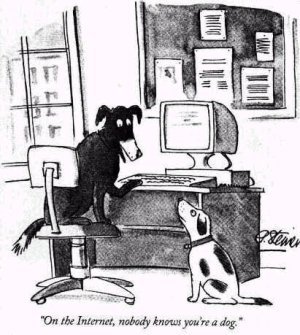
July 1993. The New Yorker published a cartoon by Peter Steiner depicting a dog sitting at a computer informing another dog sitting on the floor that: On the internet, nobody knows you’re a dog.
November 1993. I got my first Unix account in order to participate alt.arts.nomad, the USENET component of an exhibition by Ingrid Bachmann called Nomad Web: Sleeping Beauty awakes, which was the first networked-art project in Canada, as far as I know. On the internet, nobody knew I was a fiction writer. Not even me.
May 1995. I graduated from Concordia University, in Montreal, Quebec, with a BFA in Studio Art, with a concentration in Fibres and Sculpture, with distinction, approximately 1.1 months after Netscape Navigator 1.1 was released.
November 1995. I made my first web art writing project during a thematic residency at The Banff Centre for the Arts, as The Banff Centre was then known. The theme of the residency was Telling Stories: Telling Tales. I told them I was a writer, and they believed me. The web piece I made there was called Fishes and Flying Things. It remediated a paper zine printed from a QuarkExpress file stored on a 44 MB SyQuest cartridge which I still own but the contents of which I can no longer access. The images were digital scans of photocopies of borrowed books no longer in my possession. The text was based on the title of an installation art exhibition I had work included in Montreal at the time, of which, other than an event poster, no physical or documentary evidence remains. Upon my return from Banff to Montreal, my artist friends informed me that web-based work was elitist, because so few people could access it, and my writer friends assured me that the internet would never catch on. Fishes and Flying Things is still online and it still works.
November 1998. I gave an artist’s talk called A Little Talk About Reproduction at a web art exhibition called Maid in Cyberspace – Encore!, hosted by Studio XX, a feminist artist-run centre for technological exploration, creation and critique founded in Montreal in 1996. This talk reflected on the formal transition I’d made from zine to web, from the vast perspective offered by the passage of three whole years. On the internet, nobody knows how far we’ve come.
February 2010. I gave an artist’s talk called A Little Talk About Reproduction at In(ter)ventions: Literary Practice at the Edge, a gathering held at The Banff Centre. The first talk had been prognostic, to use Walter Benjamin’s term. By the time of the second, we might say that everything expected of the future had long since transpired. Except, we had no idea what to expect. We might say that in the age of computational production longevity lends aura to a work. Except. On the internet, nobody knows how far we have left to go.
June 2008. I made a web-based work called in absentia with the support of Dare-Dare, an artist-run centre which, at that time, was operating out of a trailer in a vacant lot in the Mile End neighbourhood of Montreal. The launch event was a six-hour outdoor neighbourhood block party attended by over a thousand people. The work was projected on the underside of a viaduct. There were DJ’s and bar-tenders and Port-o-Let portable toilets rented especially for the occasion. The police came six times. No arrests were made.
November 2012. Alexandra Saemmer suggested, in Evaluating digital literature: social networks, selection processes and criteria, a paper presented at Remediating the Social, Edinburgh, that Tweet
September 10, 2013
. . . and by islands I mean paragraphs.
. . . and by islands I mean paragraphs casts a reader a drift in a sea of white space extending far beyond the horizon of the browser window, to the north, south, east and west. Navigating (with mouse, track pad, arrow keys, or touchscreen) reveals that this sea is dotted with islands… and by islands I mean paragraphs. These paragraphs are computer-generated. Their fluid compositions draw upon variable strings containing fragments of text harvested from a larger literary corpus – Deluze’s Desert Islands, Shakespeare’s The Tempest, Defoe’s Robinson Crusoe, Bishop’s Crusoe in England, Coetzee’s Foe, Ballard’s Concrete Island, Hakluyt’s Voyages and Discoveries, and lesser-known sources including an out-of-date guidebook to the Scottish Isles and an amalgam of accounts of the classical and possibly fictional island of Thule. Individually, each of these textual islands is a topic – from the Greek topos, meaning place. Collectively they constitute a topographical map of a sustained practice of reading and re-reading and writing and re-writing islands. In this constantly shifting sea of variable texts one never finds the same islands twice… and by islands, I do mean paragraphs.
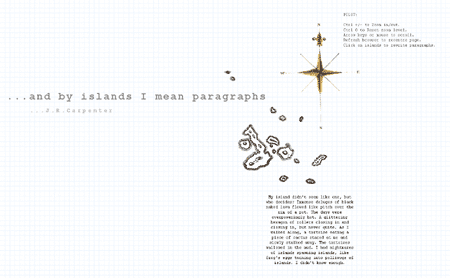
…and by islands I mean paragraphs will launch at Les littératures numériques d’hier à demain, an exhibition of digital literature to take place at the Bibliothèque Nationale de France, in conjunction with Chercher le texte, Paris, France, 24 September – 1 December 2013.
Chercher le texte Virtual Gallery
View …and by islands I mean paragraphs
Tweet
July 4, 2013
Writing on Writing on Performance Writing
Performance Writing is one of those unwieldy terms – not quite familiar enough for us to assume we already know what it means, not quite descriptive enough for us to simply guess. Fitting, then, that this term refers to a field with a willful unwillingness to commit to fixed definitions. In Thirteen Ways of Talking about Performance Writing, a lecture given to all first year undergraduates of Dartington College of Arts on Tuesday 22nd November 1994, in the inaugural term of a new undergraduate degree called Performance Writing, John Hall advocates for definings rather than definitions:
Like ‘writing’ ‘defining’ can best be treated as a gerund, catching the present tense of the verb up into a noun, without losing the continuous dynamic of the verb: the process of the act of defining. If the process were to end in resolution we would move the defining into definition. We would know.
We won’t.
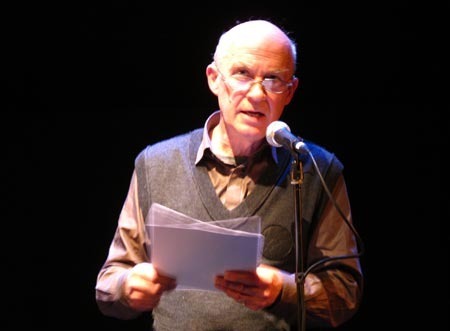
John Hall performing at Performance Writing Weekend 2012, Arnolfini, Bristol, May 2012.
To consider the term Performance Writing in explicitly Performance Writing terms, the ineligibility of the term is intertwined both with the context of its production and of its consumption. At one time those were one in the same. Dartington College of Art was a specialist performance arts institution which operated in South Devon, England, from 1961-2008. It evolved out of a particular and somewhat peculiar mixture of the Dartington Hall experiment in rural regeneration led by Dorthy and Leonard Elmhirst in the 1920s, and the alternative education experiments of both the Dartington Hall School and the Steiner School which operated on the same site. In the 1970s the Theater department at Dartington College of Art was heavily influenced by post-modern modes of writing for performance which had emerged from Black Mountain College in North Carolina in the 1950s. The discussions which led to the development of Performance Writing as a set of independent practices at Dartington began in 1987. The BA was founded by John Hall in 1994, the MA in 1999, and practice-led PhD research in Performance Writing also began at this time.
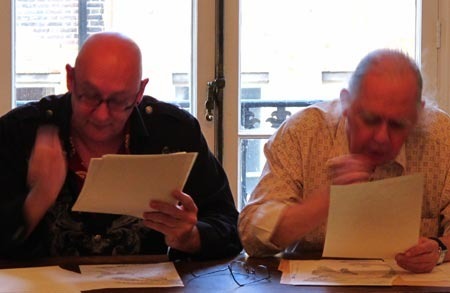
Steve McCaffery and cris cheek performing Carnival live at Birkbeck, London, UK, 06 June 2012
Performance Writing pedagogy, methodology, and practices were developed by active practitioner-lecturers at Dartington, including John Hall, Ric Allsopp, Caroline Bergvall, cris cheek, Peter Jager, Barbara Bridger, Melanie Thompson, Jerome Fletcher, and many others, and enriched by an program of visiting artists from around the world. From the outset, Performance Writing has taken a consistently broad and overtly interdisciplinary approach to what writing is and what writing does in a range of social and disciplinary contexts, exploring writing and textual practice in relation to visual art, digital media, installation, performance, collaborative practices and sound/audio work, as well as book art and page-based media. The democratic, inclusive, and above all extensible nature of Performance Writing methodology has led to its adoption and adaptation by both independent and academic researchers, practitioners, pedagogs, and institutions in places as far flung as: Aarhus, Denmark; Berne, Switzerland; Oakland, California; Banff, Canada.
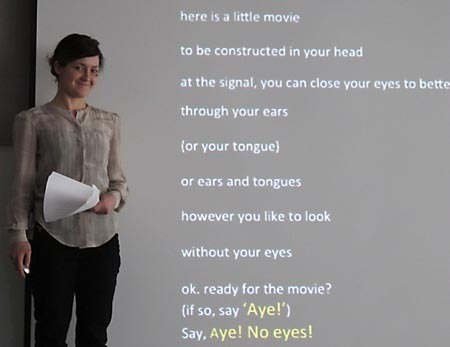
Erin Robinsong performing at In(ter)ventions: Literary Practice at the Edge, The Banff Centre, February 2011
In the UK, Performance Writing methodologies and sensibilities have spread – primarily through graduates of the the program at Dartington – into a rich diversity of artistic forms and institutional formulations, including but by no means limited to: performance in/with digital literature, as explored by Jerome Fletcher in the context of the HERA-funded research project ELMCIP; thematic multi-diciplinary writing workshops, as led by Devon-based Writing&; digital glitch literature and electronic voice phenomena performance, as explored by Liverpool and London based Mercy; conceptual writing and small press publishing, as explored by Leeds based Nick Thurston, and language and voice as explored by Bristol-based salon series Tertulia. I have no idea if Text Festival in Bury has ever heard of Performance Writing, but it certainly appears to be profoundly ‘Performance Writing’ in nature. Affinities with Performance Writing are also evident, though not in name, in the MFA in Art Writing led by Maria Fusco at Goldsmiths University, London, as well as the Writing-PAD initiatives at Goldsmiths University, which include the publication of the Journal of Writing in Creative Practice, which will put out a special issue dedicated to Performance Writing late 2013 or early 2014. Performance Writing sensibilities also appear to be emerging within the CRASSH research centre at Cambridge University, which recently held the excellent seminar: Beyond the authority of the ‘text’: performance as paradigm, past and present.
Performance Writing as paradigm (at present) appears to be expanding from a disappearing centre (its past). Which is to say, Performance Writing is currently undergoing a paradigm shift.
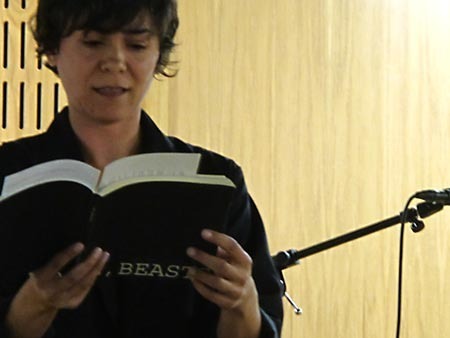
Oana Avasilichioaei performing We, Beasts at Environmental Utterance, University College Falmouth, 2 September 2012.
In 2008 Dartington College of Art merged with University College Falmouth, Cornwall. The relocation to Cornwall was completed in 2010, at which point, University College Falmouth, incorporating Dartington College of Art, as the institution became known, ceased recruitment to the BA Performance Writing. It has not resumed. The MA Performance Writing, led by Jerome Fletcher, continued to run at Arnolfini, a major European art and performance centre in Bristol, UK. Two Performance Writing Weekend festivals have been held at Arnolfini: PW10, and PW12. Recruitment to the MA Performance Writing was ceased in 2012. It has not resumed. Performance Writing continues at the postgraduate and research level at what is now called Falmouth University, where I am now nearing the completion of a practice-led PhD, which will in fact be awarded by University of the Arts London, but which in my mind remains entwined with the pedagogy, methodology, and practices of Performance Writing, Dartington College of Art.
What’s in a name anyway?
Earlier in this post I proposed that the ineligibility of the term Performance Writing is intertwined both with the context of its production and of its consumption. How can this term and the sets of practices it refers to be understood in its current institutional context? All trace of Performance Writing programs and pedagogy past have been erased from both the Dartington and the Falmouth websites. As there is no new student intake, Performance Writing is not being taught at either the undergraduate or graduate levels. Thus, Performance Writing is divorced from both the context of its own production and the possibility of its own consumption.
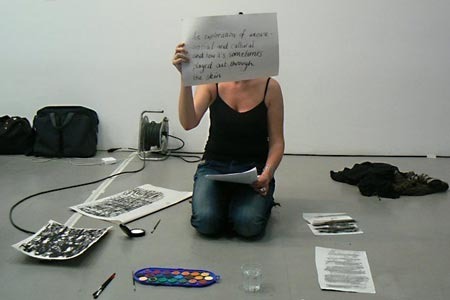
Writing & the Body workshop, Arnolfini, Bristol, 2012.
In addition to its willful unwillingness to commit to fixed definitions, Performance Writing has long eschewed any suggestion of a fixed corpus, preferring rather to assemble a fresh corpus around each new set of questions posed. Perversely, my question here is: what comprises the corpus of writing on Performance Writing? Paradoxically, as Performance Writing expands and evolves in new contexts, its corpus grows exponentially, but so too do its variables. Art Writing. Conceptual Writing. Performance Poetry. Sound Poetry. Digital Literature. Alt Lit. As these terms and conditions shift their names become many, which makes writing on writing in the field harder and harder to Google.
Here then is a collection of texts which directly address (or perform) Performance Writing in the Dartington sense of the term. This list is neither means exhaustive, nor fixed. Please. Send names and links and references. I’ll gladly add them:
Ric Allsopp, “Performance Writing,” in PAJ: A Journal of Performance and Art. Vol. 21, No. 1, 1999. pp. 76-80.
Caroline Bergvall, What do we mean by Performance Writing? (PDF) a keynote address delivered at the opening of the first Symposium of Performance Writing, Dartington College of Arts, 12 April 1996.
Barbara Bridger, Dramaturgy and the Digital in Exeunt Magazine, 2013.
Barbara Bridger & J. R. Carpenter, “Call and Response: Toward a Digital Dramaturgy,” in Journal of Writing and Creative Practice. Goldsmiths, London, UK (forthcoming)
David Buuck, What is performance writing? in Jacket2, 2013.
J. R. Carpenter, Performing Digital Texts in European Contexts, commentary column on Jacket2, 2011.
J. R. Carpenter, Where performance and digital literature meet…, The Literary Platform, May 2012.
cris cheek, Reading and Writing: the Sites of Performance in How2, Volume 3, Issue 3, 2009.
Jerome Fletcher, Performing …Reusement. E-composition / Decomposition (PDF), inCybertext Yearbook, University of Jyväskylä, 2010.
Maria Fusco, Michael Newman, Adrian Rifkin and Yve Lomax, 11 Statements Around Art Writing, Freize, 2011.
John Hall, Thirteen Ways of Talking about Performance Writing, Plymouth: PCAD, 2008.
John Hall, Essays on Performance Writing, Poetics and Poetry Vol. 1. On Performance Writing, with pedagogical sketches, forthcoming from Shearsman Books, October 2013.
Carl Lavery & David Williams eds, Good Luck Everybody: Lone Twin – Journeys, Performances, conversations, Performance Research Books, 2011.
Della Pollock, Performing Wiring (PDF), in The Ends of Performance. eds. Peggy Phelan, Jill Lane, NY: NYU Press, 1998. pp 73-103
Three recent anthologies which have no idea how Performance Writing they are.
In addition to the above list, there are numerous works which, although not expressly performance writing in name, are profoundly performance writing in nature. Listed here are but a very few of those:
Walter Benjamin, The Arcades Project, Harvard University Press, 2002.
Deleuze and Guattari, Kafka: Toward a Minor Literature, U of Minnesota Press, 1986.
Jean-Jacques Lecercle, A Marxist Philosophy of Language. trans. Gregory Elliot. Leiden & Boston: Brill, 2006.
W. G. Sebald, Rings of Saturn, Vintage, 2002.
Situationist International Text Library
Gertrude Stein, How To Write, NY: Dover, 1975.
McKenzie Wark, A Hacker Manifesto. (PDF) Harvard University Press, 2004.
The field of Performance Writing has of course produced a rich corpus of creative works, far too numerous to mention here.
For more information about Performance Writing, and/or to participate in ongoing workshops, events, and activities, visit:
Performance Writing entry on Wikipedia
(this page needs updating)
Performance Writing group on Facebook
(1,157 followers at the time of this writing)
Writing & multi-diciplinary writing workshop series
(led by former Dartington Performance Writing Faculty)
Tertulia
(Bristol-based salon series)
In(ter)ventions: Literary Practice at the Edge residency program at The Banff Centre
(where I am Performance Writing Faculty)
Tweet
May 22, 2013
TRANS.MISSION [A.DIALOGUE] in &NOW AWARDS 2: The Best Innovative Writing
A print extract and brief description of my computer-generated narrative dialogue TRANS.MISSION [A.DIALOGUE] has been published in &NOW AWARDS 2: The Best Innovative Writing, a new anthology from &NOW Books.
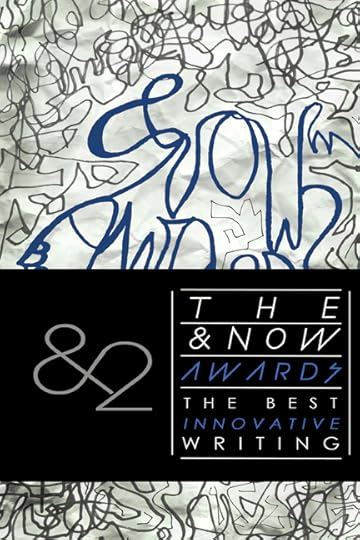
The book has two front covers (though one looks more front-like than the other). It can be read from either direction. The introductions to both sides state: “There are two ‘sides’ to the book. These ‘sides’ mirror each other, except when they do not.”
The page numbers don’t quite bear this out, but somehow I suspect I have Nick Montfort to thank for my inclusion in this anthology. Roughly the other side of the book from TRANS.MISSION [A.DIALOGUE] is Nick’s contribution to the volume – a page each of output from the Latin and Cyrillic versions of “Letterformed Terrain,” from Concrete Perl, a set of four concrete poems realized as 32-character Perl programs. The source code of TRANS.MISSION [A.DIALOGUE] is adapted from another of Nick’s pieces, The Two, so whether intentional on the part of the editors or not, these two pieces are engaged in a conversion of sorts.
In any case, I’m delighted to see print anthologies endeavoring to represent experimental digital literature, and I’m honoured to be included in this book, in such great company.
Here’s what the publishers have to say:
This second volume of The &Now Awards recognizes the most provocative, hardest-hitting, deadly serious, patently absurd, cutting-edge, avant-everything-and-nothing work from the years 2009–11. The &NOW Awards features writing as a contemporary art form: writing as it is practiced today by authors who consciously treat their work as an art, and as a practice explicitly aware of its own literary and extra-literary history— as much about its form and materials, language, as it about its subject matter. The &NOW conference, moving from the University of Notre Dame (2004), Lake Forest College (2006), Chapman University (2008), the University at Buffalo (2009), the University of California, San Diego (2011), and Paris (Sorbonne and Diderot, 2012)—sets the stage for this aesthetic, while The &Now Awards features work from the wider world of innovative publishing and serves as an ideal survey of the contemporary scene.
&NOW AWARDS 2: The Best Innovative Writing is edited by Davis Schneiderman. It will be available for purchase from Northwestern University Press and from Amazon as of 25 May 2013.
More information about TRANS.MISSION [A.DIALOGUE]
Tweet
February 4, 2013
Notes on the Voyage: From Mainframe Experimentalism to Electronic Literature
I’m giving a talk at the Alberta College of Art and Design (ACAD) on Thursday, 7 February. The title on the poster is: Notes on the Voyage: From Mainframe Experimentalism to Electronic Literature. But somehow or other, my first slide is of the via Appia antica. Roman roads are among the best examples we have of classical networks, after all. Don’t worry. It only takes 14 slides to arrive at an image of Rear Admiral Grace Hopper working with the UNIVAC computer, which she helped develop. The first UNIVAC shipped on March 31, 1951. The first experiment with digital literature and digital art of any kind was carried out one year later by Christopher Strachey, working on the Manchester University Computer, for which, Alan Turing wrote the manual. And so on. Come by if you can.
Thursday February 7, 2013 | Room 595 | 12:30–1:30 PM
ALBERTA COLLEGE OF ART + DESIGN 1407 14TH AVENUE N.W. CALGARY WWW.ACAD.CA
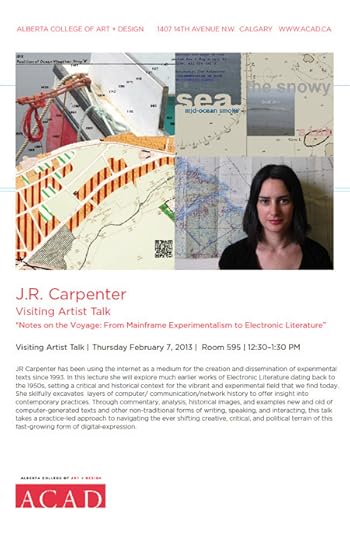
Here’s what it says in the text on the poster that is probably too small to read:
JR Carpenter has been using the internet as a medium for the creation and dissemination of experimental texts since 1993. In this lecture she will explore much earlier works of Electronic Literature dating back to the 1950s, setting a critical and historical context for the vibrant and experimental field that we find today. She skilfully excavates layers of computer/ communication/network history to o�er insight into contemporary practices. Through commentary, analysis, historical images, and examples new and old of computer-generated texts and other non-traditional forms of writing, speaking, and interacting, this talk takes a practice-led approach to navigating the ever shifting creative, critical, and political terrain of this fast-growing form of digital-expression.
Tweet
January 2, 2013
Notes on the Voyage of Owl and Girl
Announcing Notes on the Voyage of Owl and Girl, a brand new work of web-based computer-generated digital literature created especially for “Avenues of Access: An Exhibit & Online Archive of New ‘Born Digital’ Literature,” curated by Dene Grigar & Kathi Inman Berens. The exhibition will be held in conjunction with the MLA 2013 Convention in Boston, 3-5 January 2013, but the website – containing links to 30 new born digital works and a plethora of resources pertaining to born digital literature – is online now: Avenues of Access: An Exhibit & Online Archive of New ‘Born Digital’ Literature
![J. R. Carpenter || Notes on the Voyage of Owl and Girl [detail]](https://i.gr-assets.com/images/S/compressed.photo.goodreads.com/hostedimages/1381078023i/4107573.jpg)
Notes on the Voyage of Owl and Girl is a work of fiction. Any resemblance to actual events, persons, places or texts is entirely intentional. Details from many a high sea story have been netted by this net-worked work. The combinatorial powers of computer-generated narrative conflate and confabulate characters, facts, and forms of narrative accounts of sea voyages into the unknown North undertaken over the past 2340 years. At the furthest edge of this assemblage floats the fantastical classical island of Ultima Thule and the strange phenomenon known to the Romans as sea lung. The main characters are sprung from Edward Leer’s Victorian nonsense poem, The Owl and the Pussycat. A lazy and somewhat laconic owl and a girl most serious, most adventurous, most determined, have set sail toward this strange sea in a boat of pea-, bottle-, lima-bean- or similar shade of green. The cartographic collage they voyage through collects the particularities of a number of fluid floating places – as described or imagined in sources as diverse as Hakluyt’s Voyages and Discoveries and the children’s poem Wynken, Blynken and Nod – and reacontextualizes them in an obviously awkward assemblage of discontinuous surfaces pitted with points of departure, escape routes, lines of flight.
For more information on the source texts, maps, and codes pillaged for this work, please see Notes on Notes on the Voyage of Owl and Girl.
Tweet
December 19, 2012
Along the Briny Beach included in the ELMCIP Anthology of European Electronic Literature
My web-based computer-generated narrative / poem / performance machine, Along the Briny Beach, is included in the ELMCIP Anthology of European Electronic Literature, edited by Maria Engberg, Talan Memmott, and David Prater. The anthology officially launched with the distribution of USB drives at the ELMICP conference Remediating the Social, which took place in Edinburgh, 1-3 November 2012, and is now available online: http://anthology.elmcip.net
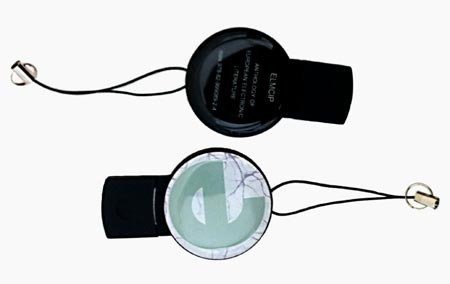
Of Along the Briny Beach, the ELMCIP Anthology editors have this to say:
Using scripts both generative and performative, the work is a continuous rewriting of itself. Though much of the text is appropriated from other sources –Conrad, Carroll, and Charles Darwin – we can still call Carpenter the author of the work due to the intentional selection of appropriated texts and their rearrangement, or reconfiguration as Along the Briny Beach. From the consistency in selected works – all have to do with the sea – to the sea foam green color palette; Carpenter presents text as integration between writing, function, and design.
The ELMCIP Anthology contains works by 18 authors, as well as a selection of videos, essays, syllabi, and other teaching materials pertaining to Electronic Literature. For more information about ELMCIP, visit: http://elmcip.net/
Tweet

